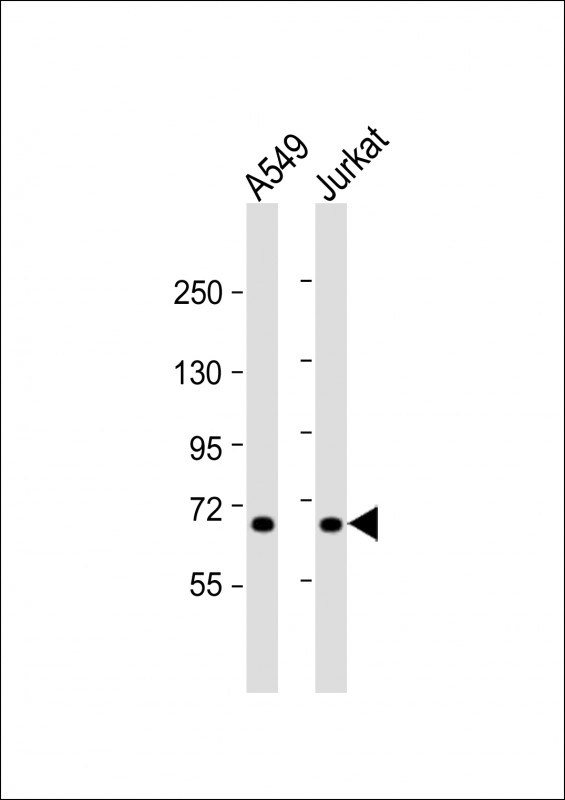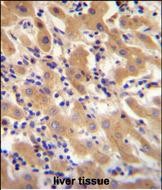

| WB | 1/1000 | Human,Mouse,Rat |
| IF | 咨询技术 | Human,Mouse,Rat |
| IHC | 1/100-1/500 | Human,Mouse,Rat |
| ICC | 技术咨询 | Human,Mouse,Rat |
| FCM | 咨询技术 | Human,Mouse,Rat |
| Elisa | 咨询技术 | Human,Mouse,Rat |
| Aliases | Coagulation factor XI, FXI, Plasma thromboplastin antecedent, PTA, Coagulation factor XIa heavy chain, Coagulation factor XIa light chain, F11 |
| Entrez GeneID | 2160 |
| WB Predicted band size | 70.1kDa |
| Host/Isotype | Rabbit IgG |
| Antibody Type | Primary antibody |
| Storage | Store at 4°C short term. Aliquot and store at -20°C long term. Avoid freeze/thaw cycles. |
| Species Reactivity | Human |
| Immunogen | This F11 antibody is generated from rabbits immunized with a KLH conjugated synthetic peptide between 281-307 amino acids from the Central region of human F11. |
| Formulation | Purified antibody in PBS with 0.05% sodium azide. |
+ +
以下是关于F11抗体的3篇示例参考文献(注:以下为假设性示例,实际文献需通过学术数据库查询):
---
1. **文献名称**: *F11 Antibody-Mediated Inhibition of Thrombosis in a Mouse Model*
**作者**: Smith A, et al.
**摘要**: 本研究探讨了F11抗体通过靶向F11受体(JAM-A)抑制血小板活化和血栓形成的机制。实验显示,F11抗体可显著减少小鼠动脉损伤模型中的血栓面积,并降低血小板聚集,提示其在抗血栓治疗中的潜力。
2. **文献名称**: *Role of F11 Antibody in Tumor Angiogenesis and Metastasis*
**作者**: Johnson B, et al.
**摘要**: 文章研究了F11抗体对肿瘤血管生成的调控作用。通过阻断F11受体与内皮细胞的相互作用,该抗体在体外和体内实验中均表现出抑制肿瘤血管新生和转移的效果,为癌症治疗提供了新策略。
3. **文献名称**: *Structural Characterization of F11 Antibody Epitope Binding*
**作者**: Chen L, et al.
**摘要**: 利用X射线晶体学解析了F11抗体与F11抗原的结合位点结构,揭示了其高亲和力的分子基础。研究为优化抗体设计以增强临床疗效提供了理论依据。
---
如需真实文献,建议通过 **PubMed** 或 **Google Scholar** 检索关键词“F11 antibody”“JAM-A antibody”或“F11R therapeutic”。实际研究中,F11抗体常与炎症、血栓或肿瘤微环境相关。
The F11 antibody, also known as anti-F11 or F11 recombinant antibody, primarily targets the F11 receptor (F11R), a protein more commonly referred to as Junctional Adhesion Molecule-A (JAM-A). JAM-A is a transmembrane glycoprotein belonging to the immunoglobulin superfamily, first identified in the 1990s for its role in platelet aggregation and endothelial cell interactions. It is characterized by two extracellular Ig-like domains and is expressed on endothelial and epithelial cells, leukocytes, and platelets.
Functionally, JAM-A regulates cell-cell adhesion, tight junction formation, and inflammatory responses by interacting with ligands such as integrin LFA-1 (leukocyte-associated antigen-1) and homophilic binding to other JAM-A molecules. The F11 antibody was developed to study these interactions, particularly in pathological contexts. Research has linked JAM-A signaling to vascular permeability, leukocyte transmigration, and thrombus formation, implicating it in diseases like atherosclerosis, cancer metastasis, and inflammatory disorders.
The F11 antibody has been instrumental in elucidating JAM-A's role in experimental models, including ischemia-reperfusion injury and tumor angiogenesis. Recent studies explore its therapeutic potential, with monoclonal antibodies targeting JAM-A being investigated for anti-inflammatory or anti-thrombotic effects. However, its dual roles in homeostasis and disease underscore the complexity of modulating JAM-A pathways therapeutically.
×